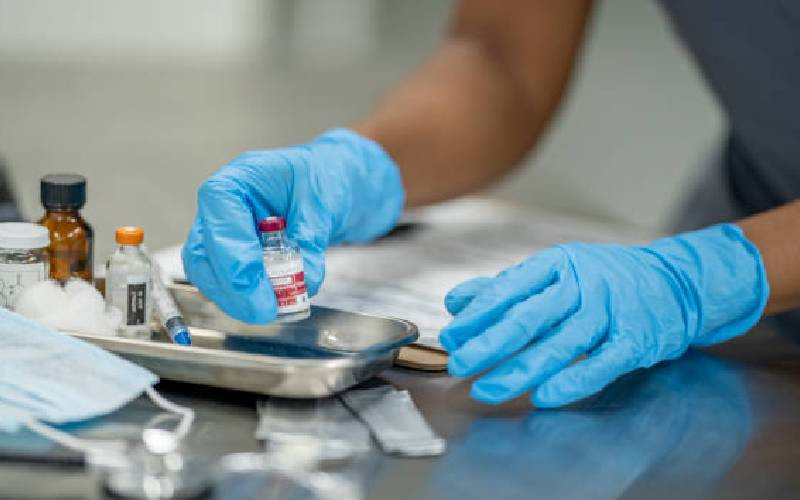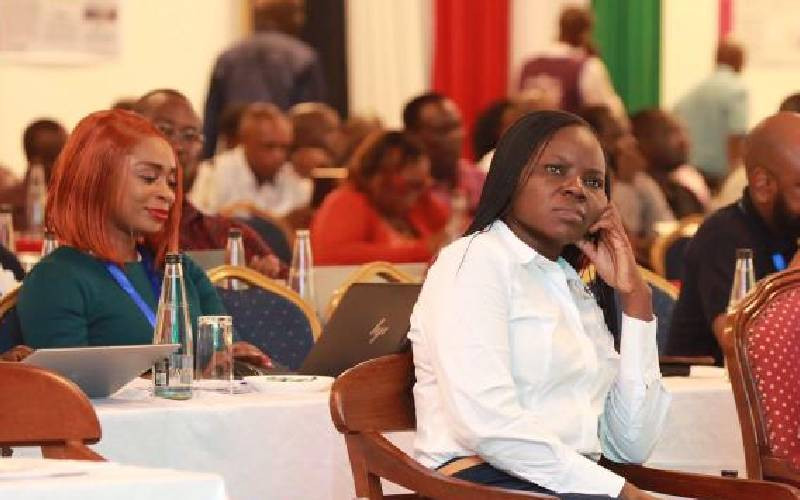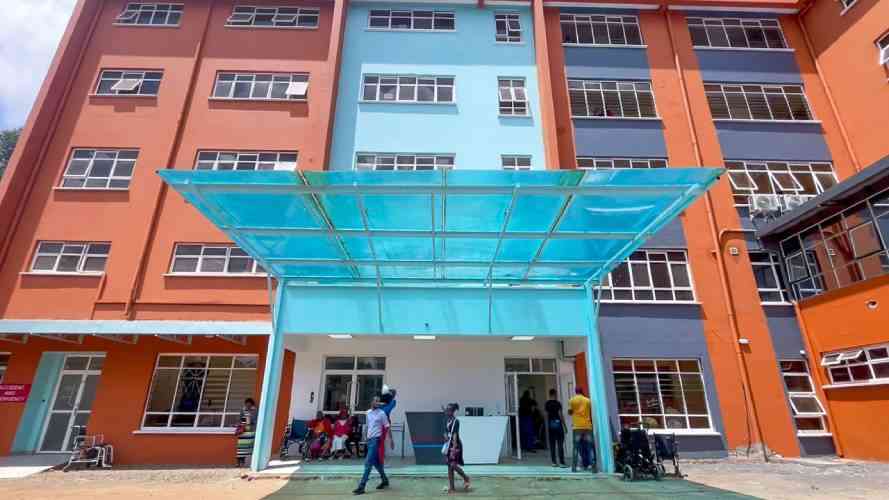
Health Cabinet Secretary, Susan Nakhumicha, on Wednesday, continued drumming up support for the ongoing reforms in the health sector, especially the transition from the defunct National Health Insurance Fund (NHIF) to the Social Health Authority (SHA).
This comes ahead of the Friday launch of the SHA membership registration drive.
The CS is proposing redesigning the HIV response to align with the aspirations of the Universal Health Coverage (UHC) agenda, by espousing the "leaving no one behind" mantra.
She was in Mombasa, where she opened the HIV Service Delivery Integration Summit, hosted by the National AIDS and STI Control Program (NASCOP).
In her remarks, she said the war against HIV is one of the key concerns for the government in its efforts to achieve UHC.
"In this regard, it is important to note that HIV care is included in the package even as the transition of financing models is discussed," the CS said.
Nakhumicha highlighted the need for restructuring the HIV response to align the funding available in the HIV response in support of operationalising the SHA, which includes HIV prevention and control in the Essential Benefits Package within the context of publicly financed primary healthcare.
Nakhumicha told the Summit that clients are at the Centre for Non-Communicable Diseases (NCDs) and Advanced HIV disease is captured under the new model, which, she termed as “the good news”.
- NHIF assures Kenyans as it prepares for transition
- Empowering mothers key to reducing maternal and perinatal deaths
- Kenya committed to bringing an end to endemic malaria
- Why we must up spending on public sanitation
Keep Reading
"I urge all our Persons Living with HIV to enrol and be members of SHA," she said, noting that UHC provides access to integrated, people-centred healthcare services to secure progress towards ending HIV as a public health threat.
"And this includes a review of financial support models from stakeholders, including PEPFAR to increase proportional funding through Government-to-Government funding mechanisms at all levels," she stated.
The CS said while building on President William Ruto’s health reforms to operationalise UHC through the primary health care (PHC) strategy, as the anchor for the transformation of the HIV program at all levels, especially at the county level.
She also added that Kenya will redesign HIV service delivery models to increase efficiency, promote equity, and maximize resource utilisation. This, she said, is key to achieving the goal of ending HIV as a public health threat.
"In this regard, let the stigmatised stand-alone labelling of HIV services and clients in facilities cease by reorganisation of service delivery point through integration to other service delivery areas or transformation into broader chronic care models," Nakhumicha said.
The CS also called for the strengthening and utilisation of Kenya’s enormous potential for local manufacturing of pharmaceutical and healthcare products to significantly contribute to HIV commodity security; while also propelling Kenya towards sustainable growth.
Kenya boasts the largest pharmaceutical industry in both the East African Community and the Common Market for Eastern and Southern Africa (COMESA) regions, capable of producing over 90 per cent of drugs on the essential medicines list, she insisted.
"Innovation and Digitisation as prioritised by GOK, through the enactment of the Digital Health Act 2023 within the ministry's public health strategy, is core," she added.
"Let us all fast track and commit to this frontier as it holds potential for increased access to services, efficiency and cost saving," she urged the Summit, noting that the ongoing meeting is happening at an opportune time when the proposals - to best align the HIV response to the reforms currently going on in the healthcare sector”, said the CS.
As of the end of December 2023, 1,336,234 people were living with HIV in Kenya, with 1.2 million being on treatment.
At the same time, there are currently 8,851 HIV testing sites and 3,752 treatment sites (over 2000 digitised) encompassing public, private, and faith-based organisations-supported facilities in the country.
At least 90 per cent of people living with HIV receive care at level 2 to level 4 health facilities.
Data from the ministry show that within the last ten years, there has been a remarkable decline in new HIV infections, HIV-related mortality, and mother-to-child transmission by 78 per cent, 68 per cent, and 65 per cent respectively.
Siaya County has achieved the less than 5 per cent target of eliminating mother-to-child transmission.
And despite achievements made in the fight against HIV/AIDS, Nakhumicha regretted that stigma continues to affect the quality of life among people living with the disease in the country.
And this, she noted makes people living with the disease to shy away from seeking care, with a number dying of AIDS.
"Quality of life for people living with HIV on a long-term treatment is an emerging concern, more so with increased risk of NCDs and mental health needs," she said, noting that despite the achievements, still gaps exist in client outcomes among specific subpopulations, geographical inequalities while stigma continues to impede optimal HIV outcomes.
Contributors to stigma according to the CS is the virus-only tragedy-specific care that leads to suboptimal outcomes and non-responsive client experience within the health system.
“The isolation and specialized labelling of stand-alone HIV comprehensive care clinics further contributes to stigma and discrimination within health facilities,” she said.
The ministry plans to address stigma through the actualisation of UHC through the primary health care strategy as the anchor for the transformation of the HIV program at all levels, especially at the county level.
At the ongoing Summit, County Governments; government agencies and partners, are discussing health commodities, health financing and integration of services amid the growing number of HIV patients suffering from cancers like cancer of the cervix.
As the country moves towards the target of ending HIV/AIDS in children by 2027, Kenya’s mother-to-child stands at 8.6 per cent, against World Health Organisation (WHO), targets of below five per cent.
Siaya is the only county that has achieved the target, with only 4 per cent mother-child transmission.
Nakhumicha attributed this achievement to strong partnerships and collaborations.
“The partnership has laid a solid ground where today we can jointly advance global efforts to end HIV/AIDS as a public health threat and strengthen public health systems,” said the CS.
NASCOP Chief Executive Officer, Dr Rose Wafula, said Kenya is on course to ending HIV/AIDS in children by 2027, through the involvement of policy and guidelines formulation.
“The plan to end HIV transmission in children is an embodiment of interventions that are being implemented to close the tap of new HIV infections,” said Wafula.
Wafula remained optimistic that AIDS in children will be eliminated by 2027, in addition to ending mother-to-child transmission of HIV, Syphilis and Hepatitis.
The targets, she said, will be achieved by application of best practices of quality care for all pregnant and breastfeeding women.
Kenya’s first HIV case was detected in 1984, and in 1999, the government declared HIV/AIDS a national disaster.
At the discovery of the disease, there were no medicine and dozens of patients died lonely deaths, after years of stigma.
Nakhumicha said the government has continuously implemented various strategic frameworks, enacted many supportive legislations and established coordinating bodies to support the response.
“Throughout the response, the government has prioritized strengthening the healthcare system to address the HIV pandemic and other public health challenges,” she revealed.
The CS added, “I am pleased to note that as a country we have come a long way and have made remarkable progress. Through concerted efforts by the government, we have managed to lower the rate of infection and overall prevalence rate while enhancing care for those infected.”
There are currently 8,851 HIV testing sites and 3,752 treatment centres encompassing public, private, and faith-based organizations-supported facilities in the country. This is part of the government’s efforts to bring these health services closer to populations.
As donor funding comes to an end, the CS said there is a review of the financial support model from stakeholders to increase proportional funding through Government-to-Government funding mechanisms at all levels.
 The Standard Group Plc is a multi-media organization with investments in media platforms spanning newspaper print
operations, television, radio broadcasting, digital and online services. The Standard Group is recognized as a
leading multi-media house in Kenya with a key influence in matters of national and international interest.
The Standard Group Plc is a multi-media organization with investments in media platforms spanning newspaper print
operations, television, radio broadcasting, digital and online services. The Standard Group is recognized as a
leading multi-media house in Kenya with a key influence in matters of national and international interest.











